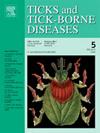蜱叮咬史与含明胶疫苗安全性之间的关系:对美国大型数据库的分析。
IF 3.4
2区 医学
Q2 INFECTIOUS DISEASES
引用次数: 0
摘要
α -半乳糖综合征(AGS)是对含明胶疫苗中的糖分子α -半乳糖致敏引起的过敏反应。蜱虫叮咬可以诱导α -半乳糖IgE致敏,因为蜱虫通过唾液注入α -半乳糖。然而,在有蜱虫叮咬史的患者中,没有关于含明胶疫苗的过敏反应率的真实数据。我们利用研究网络数据库TriNetX分析了2024年11月的数据。蜱叮咬史(即存在蜱叮咬史)分为三组:埃立体病、土拉菌病和无毒节肢动物叮咬。疫苗分为两类:(1)含明胶疫苗(鼻内活流感疫苗[fluumist]、水痘、麻疹/腮腺炎/风疹疫苗[MMR]、口服伤寒、狂犬病疫苗[RabAvert]和黄热病疫苗[YF-VAX])和(2)无明胶疫苗。有蜱虫叮咬史的患者在接种疫苗后一天内出现过敏反应。埃立克体病、兔吸虫病和无毒节肢动物咬伤患者接种含明胶疫苗后的过敏反应率分别为0.06%、0.7%和0.2%。相比之下,接受无明胶疫苗后的过敏反应率在埃利希体病、土拉菌病和无毒节肢动物咬伤患者中分别为0.04%、0.0%和0.1%。在含明胶疫苗中,与其他含明胶疫苗相比,鼻内流感和水痘活疫苗具有更高的过敏反应率。虽然蜱叮咬与AGS有关,但蜱叮咬史并不是大多数含明胶疫苗的禁忌症,包括MMR、口服伤寒、狂犬病和黄热病疫苗。需要进一步的调查来评估鼻内流感和水痘疫苗在这一人群中的安全性。本文章由计算机程序翻译,如有差异,请以英文原文为准。
Association between tick-bite history and safety of gelatin-containing vaccines: Analysis of a large database of the United States
Alpha-gal syndrome (AGS) is an allergic reaction caused by sensitization to alpha-gal, a sugar molecule in gelatin-containing vaccines. Tick bites can induce alpha-gal IgE sensitization, as ticks inject alpha-gal through their saliva. However, there is no real-world data on the anaphylaxis rates associated with gelatin-containing vaccines in patients with tick bite history. We utilized TriNetX, a research network database, to analyze data in November 2024. The history of tick bites (i.e., the presence of a tick-bite history) was categorized into three groups: ehrlichiosis, tularemia, and bites from nonvenomous arthropods. Vaccines were classified into two categories: (1) gelatin-containing vaccines (live intranasal influenza [FluMist], varicella, measles/mumps/rubella [MMR], oral typhoid, rabies [RabAvert], and yellow fever vaccines [YF-VAX]) and (2) gelatin-free vaccines. Anaphylactic episodes were identified in patients with a history of tick bites who developed anaphylaxis within one day following vaccination. The anaphylaxis rates after receiving gelatin-containing vaccines were 0.06 %, 0.7 %, and 0.2 % in patients with ehrlichiosis, tularemia, and nonvenomous arthropod bites, respectively. In contrast, the anaphylaxis rates after receiving gelatin-free vaccines were 0.04 %, 0.0 %, and 0.1 % in patients with ehrlichiosis, tularemia, and nonvenomous arthropod bites, respectively. Among the gelatin-containing vaccines, live intranasal influenza and varicella vaccines posed a higher rate of anaphylaxis compared to other gelatin-containing vaccines. While tick bites are associated with AGS, a history of tick bites is not a contraindication for most gelatin-containing vaccines, including MMR, oral typhoid, rabies, and yellow fever vaccines. Further investigations are warranted to evaluate the safety of intranasal influenza and varicella vaccines in this population.
求助全文
通过发布文献求助,成功后即可免费获取论文全文。
去求助
来源期刊

Ticks and Tick-borne Diseases
INFECTIOUS DISEASES-MICROBIOLOGY
CiteScore
6.90
自引率
12.50%
发文量
185
审稿时长
6-12 weeks
期刊介绍:
Ticks and Tick-borne Diseases is an international, peer-reviewed scientific journal. It publishes original research papers, short communications, state-of-the-art mini-reviews, letters to the editor, clinical-case studies, announcements of pertinent international meetings, and editorials.
The journal covers a broad spectrum and brings together various disciplines, for example, zoology, microbiology, molecular biology, genetics, mathematical modelling, veterinary and human medicine. Multidisciplinary approaches and the use of conventional and novel methods/methodologies (in the field and in the laboratory) are crucial for deeper understanding of the natural processes and human behaviour/activities that result in human or animal diseases and in economic effects of ticks and tick-borne pathogens. Such understanding is essential for management of tick populations and tick-borne diseases in an effective and environmentally acceptable manner.
 求助内容:
求助内容: 应助结果提醒方式:
应助结果提醒方式:


